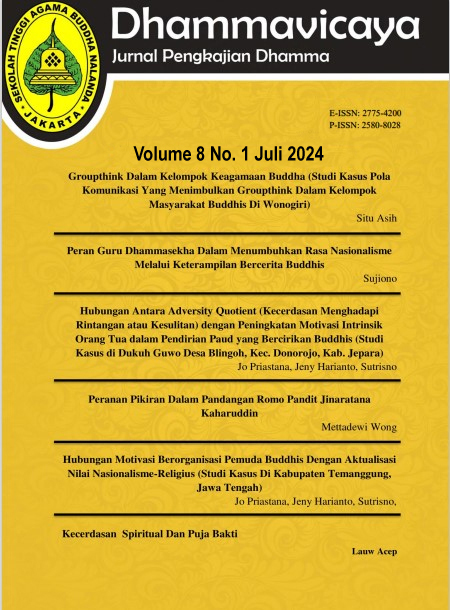Dampak Sistem Kasta terhadap Struktur Sosial Umat Buddha di Bali
DOI:
https://doi.org/10.47861/dhammavicaya.v8i1.1644Keywords:
Caste System, Impact, Social StructureAbstract
This research is to find out how the impact of the caste system in Bali on the life of the Buddhist community. In this study the method used is a qualitative research method with descriptive research results. Buddhism has been known to the Balinese people since ancient times, but in harmony with the development of Hinduism so that they were united into Shiva-Buddha. Balinese Hinduism does not use Indian Hindu culture, but the Balinese Hindu community adheres to their own culture, namely the customs of their ancestors and modern life systems. The Balinese Hindu community always carries out the Menyama Braya concept (the concept of living in harmony and respecting each other in terms of culture and differences) which has been running for generations The social structure of Buddhists in Bali is divided into gharavasa and pabbajita. Buddhists in Bali practice the teachings of the Great Teacher of Buddha, so they are not affected by the caste system that exists in social life. Buddhists in Bali promote tolerance between religions. Behaviorally, Buddhists in Bali have never adhered to the caste system or degree of social status in their daily life and always practice the teachings of Buddha Dhamma. But the Balinese Buddhist community still respects the traditions that apply in Balinese customs. In essence, the relationship between Hindus and Buddhists in Bali is not a problem at all. Because everyone respects each other. And no influence in caste either from family, education, work, marriage, and most importantly all good in thought, speech and behavior.
References
Ambedkar, B. R. (2015). Annihilation of caste: The annotated critical edition. Bombay: Government Law College.
Ariyadeva Wilegoda. (2009). The theory and practice of social revolution in early Buddhism. Colombo: Buddhist Cultural Center.
Astawa, G. O. (1996). Agama Buddha di Bali: Kajian artefaktual. Jakarta: Universitas Indonesia.
Basuki, S. (2010). Metode penelitian. Jakarta: Penaku.
Bhaiaki, I. (2019). Fakta unik tentang nama & kasta warga di Bali. Retrieved from https://www.kintamani.id/fakta-unik-tentang-nama-nama-khas-warga-bali/ on June 10, 2021.
Bhaiaki, I. (2020). Mengenal lebih lanjut sistem kasta masyarakat Bali. Retrieved from https://www.kintamani.id/mengenal-lebih-lanjut-sistem-kasta-masyarakat-bali/ on June 10, 2021.
Chandra, R. (2005). Identitas dan kejadian sistem kasta di India. New Delhi: Gyan Books.
Chodron, T. (2011). Membuka hati, menjernihkan pikiran.
Darmadi, H. (2013). Dimensi-dimensi metode penelitian pendidikan dan sosial. Bandung: Alfabeta.
Dharmantara Saras Dewi. (2007). Membongkar kasta. Jakarta: Media Indonesia.
Ghurye, G. S. (1996). Caste and race in India. New Delhi: Prakashan Populer.
Goris, R. (1948). Bali atlas kebudayaan. Pemerintah Republik Indonesia.
Hasan, M. I. (2002). Pokok-pokok materi metodologi penelitian dan aplikasinya. Bogor: Ghalia Indonesia.
Hendropuspito. (1989). Sosiologi sistematik. Yogyakarta: Kansius.
Hidayat, N., Sutrisno, S., & Permatasari, T. (2023). Transformasi Sekolah Tinggi Agama Buddha Nalanda menjadi Institut Agama Buddha Nalanda: Tinjauan studi kelayakan dalam konteks sosial budaya. Innovative: Journal of Social Science Research, 3(5), 4174-4189. Retrieved from https://j-innovative.org/index.php/Innovative/article/view/5331
Idrus, M. (2009). Pokok-pokok metodologi penelitian dan aplikasinya. Bogor: Ghalia Indonesia.
Ilaiah, K. (2005). Why I am not a Hindu: A Sudra critique of Hindu philosophy. New Delhi: Culture & Political Economy Paperback.
Kalupahana, D. N. (2008). A path of morals. Colombo: Buddhist Cultural Centre.
Kesuma, A. A. K. D. (2020). Kasta: Sebuah ajaran agama Hindu atau upaya politisasi? Retrieved from https://kmhd.ukm.ugm.ac.id/2020/06/24/kmhd-beropini/ on June 10, 2021.
Krepun, M. K. (2007). Mengurai benang kusut kasta: Membedah kiat pengajegan kasta di Bali. Denpasar: Panakom Publishing.
Lexy, J. M. (2013). Metode penelitian kualitatif. Bandung: Remaja Rosdakarya.
Miles, M. B., Huberman, A. M., & Saldana, J. (2014). Qualitative data analysis: A methods sourcebook (3rd ed.). USA: Sage Publications. (Original work published in English)
Muhajir, A. (2012). Membongkar kesalahpahaman tentang kasta di Bali. Retrieved from https://balebengong.id/kesalahpahaman-kasta-di-bali/ on June 10, 2021.
Nasikun. (1995). Sistem sosial Indonesia. Jakarta: Rajawali Pers.
Ningsih, A. F. (2019). Orientasi agama para samanera dan atthasilani di vihara Dhammadipa Arama, Mojorejo, Kota Batu, Malang, Jawa Timur. Retrieved from https://core.ac.uk/download/pdf/233636528.pdf
Purana, I. M. (2016). Konsep kasta dilihat dari kaca mata idiom estetika postmodern. Denpasar: Jurnal Kajian Pendidikan Widya Accarya FKIP, Universitas Dwijendra.
Reddy, D. S. (2005). The ethnicity of caste. Anthropological Quarterly, 78. Washington: George Washington University.
Rhys Davids, T. W. (1911). Buddhist India. New York: G.P. Putnam's Sons.
Saputra, S. (2017). Sistem kasta dalam agama Buddha. Retrieved from website samanaputta on April 6, 2021.
Sari, N. (2020). Pola kehidupan sosial keagamaan samanera samaneri di vihara Bhaisajyagurugrha Kota Bandar Lampung [PhD thesis]. UIN Raden Intan Lampung.
Sedana Arta, K., & Yuliartini, N. P. R. (2014). Studi kasus tentang konversi agama dari agama Hindu ke agama Buddha di Desa Alasangker, Kecamatan Buleleng, Kabupaten Buleleng-Bali. Universitas Pendidikan Ganesha Bali: Jurnal Ilmu Sosial dan Humaniora, Jurusan Sejarah dan Jurusan Pendidikan Pancasila dan Kewarganegaraan Fakultas Ilmu Sosial.
Segara, I. N. Y. (2019). CALEP: Catatan lepas kebudayaan. Denpasar, Bali: Watamplus & ESBE Book.
Sugiyono. (2014). Metode penelitian pendidikan: Pendekatan kuantitatif, kualitatif dan R & D. Bandung: Alfabeta.
Suryono, & Anggraeni, M. D. (2013). Metode penelitian pendidikan kualitatif dan kuantitatif dalam bidang kesehatan. Yogyakarta: Nuha Medika.
Ulfah, S. M., Octaviana, D. N., & Aqila, M. (2019). Esensi meditasi terhadap spiritualitas umat Buddha. Al-Adyan: Jurnal Studi Lintas Agama, 14(2), 269-282.
Wiana, K., & Raka, S. (1993). Kasta dalam Hindu: Kesalahpahaman selama beratus-ratus tahun. Denpasar: Yayasan Dharma Naradha.
Wijaya, E., & Indra, A. (2013). Terjemahan khotbah-khotbah menengah Sang Buddha “Majjhima Nikāya” dari judul asli The Middle Length Discourses of the Buddha. Jakarta: Dhamma Citta Press.
Downloads
Published
How to Cite
Issue
Section
License
Copyright (c) 2025 Dhammavicaya : Jurnal Pengkajian Dhamma

This work is licensed under a Creative Commons Attribution-NonCommercial-ShareAlike 4.0 International License.






